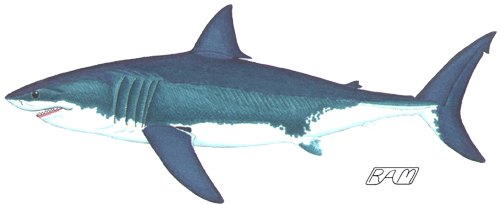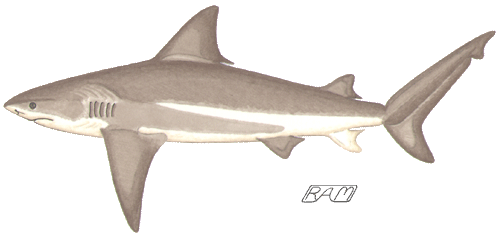The Case of the New Jersey Man-Eater
Over a 10-day period during July 1916, five shark attacks occurred along the New Jersey shore. Four of the victims died and the fifth was seriously injured. This extraordinary cluster of attacks was almost certainly the inspiration for JAWS and is among the most notorious events in the long and grim history of shark-human interactions.
The particulars of each attack — who got bitten, when, where, and how badly — have been told and re-told many times in popular shark books and documentaries. These facts are well established and most of them need not concern us here. What does seem in need of a more thorough investigation is whether one or more sharks were involved in these attacks and of what species was — or were — most likely responsible.

White Shark (Carcharodon carcharias) — since the infamous series of attacks seemed to stop with the capture of a
young White Shark, reportedly with human remains in its stomach, it was
widely assumed this animal was the culprit; other researchers are not so
sure.
Two days after the fifth attack, an 8.5-foot (2.6-metre) shark was caught in Raritan Bay, some 4 miles (6.5 kilometres) away from the mouth of Matawan Creek. It was identified as a White Shark (Carcharodon carcharias) by Dr. Frederick Lucas, who was director of the American Museum of Natural History at the time. Upon examining its stomach contents, Lucas found "the shinbone of a boy and what appeared to be part of a human rib". Since the animal's gut contained incriminating evidence and no subsequent attacks occurred, it was widely assumed that this individual was the shark responsible for the recent spate of attacks. No one seemed to be bothered that the three most recent attacks occurred 2.5 miles (4 kilometres) up tiny Matawan Creek, a very unusual habitat for a White Shark.
Nearly 60 years later, artist-author Richard Ellis uncovered some intriguing evidence that made him seriously question many long-standing assumptions about the identity of so-called 'New Jersey Man-Eater'. In his 1976 Book of Sharks, Ellis points out:
-
the first two attacks took place in the ocean, 70 and 25 miles (113 and 40 kilometres), respectively, from Matawan Creek; to assume that these distant attacks were perpetrated by the same shark that attacked three swimmers in Matawan Creek is stretching the 'rogue shark' theory beyond reasonable limits
-
the White Shark is relatively rare in New Jersey waters and is not known to enter brackish or fresh water; conversely, the Bull Shark (Carcharhinus leucas) is more abundant in New Jersey waters than the White Shark and is well known to haunt river mouths and to penetrate far up freshwater rivers
-
two days after the Matawan attacks, the New York Times reported that "the man-eating shark that killed [two swimmers] . . . was trapped in the upper reaches of Matawan Creek", a most unusual habitat for a White Shark but quite common for the Bull Shark
-
the same edition of the New York Times went on to say that, "Matawan Creek . . . was alive with sharks yesterday, according to the score of men who went out to hunt them with rifles, shotguns, boat hooks, harpoons, pikes and dynamite", implying that more than one of them may have been involved in the attacks there
-
three days after the Matawan attacks, the New York Times reported that, "a giant shark plunged through the chicken wire net that penned it in at Matawan Creek and escaped into the ocean last night", demonstrating that at least one shark swam between the Creek and the Atlantic Ocean
-
Six days after the attacks, a 7-foot, 230-pound (2.1-metre, 105-kilogram) shark was caught in Matawan Creek; Ellis suggests that this is a reasonable length-weight ratio for a carcharhinid shark, such as the Bull Shark, taking this as evidence that such a shark occurred in the Creek

Bull Shark (Carcharhinus leucas)
— this species is notorious for entering fresh water and attacking people
there,
a reputation that makes it an obvious suspect in the Matawan Creek
attacks.
In truth, 230 pounds is about 35% too heavy for a 7-foot carcharhinid and about 15% too heavy for a 7-foot White Shark. Thus, the length-weight ratio given is more consistent with that of a White Shark — but fishermen are notorious for overestimating the weight of their catches and none of the foregoing proves that this shark, captured in Matawan Creek nearly a week after the most recent attack there, was responsible for any attack on a swimmer either in the Creek or along the New Jersey seashore. Another possibility is that a Tiger Shark (Galeocerdo cuvier) may have been involved in one or more of the attacks, perhaps even in Matawan Creek. This carcharhinid species is well known to be dangerous, to enter river mouths during summer months in North Carolina and other coastal states farther south along the east coast of North America, and to travel northward along the Atlantic seaboard during summer months, regularly riding the Gulf Stream to New Jersey and even as far north as Nova Scotia, Canada.

Tiger Shark (Galeocerdo cuvier) —
could this species be the New Jersey Maneater? It seems possible but
unlikely.
So what are we to make of all this? Only that large sharks along the New Jersey coast - and even in such unexpected places as Matawan Creek — are not that unusual. The capture of an 8.5-foot White Shark in Raritan Bay two days after the spate of attacks nearby may merely be a coincidence. Although its stomach contents appeared to contain human remains, these could easily have been scavenged from the body of a drowning victim. Even during the early part of the 20th Century, dozens of drownings occurred along the New Jersey shore each year. An 8.5-foot White Shark is about 4 years old and, at that life history stage in the western North Atlantic, feeds primarily on bottom-dwelling fishes such as searobins, hakes, and skates. It seems unlikely that it was the shark responsible for all five attacks in New Jersey during July 1916. Analysis of the wounds on the victims suggest that at least three, different-sized sharks were responsible for these attacks. Based on the available data, the White Shark shows little or no inclination to enter brackish or fresh water (although a close relative of the White Shark, the Porbeagle [Lamna nasus], has recently been reported in brackish water in Argentina). So it seems unlikely that a White Shark was responsible for any of the attacks in Matawan Creek. In short: the case against the 8.5-foot White Shark captured in Raritan Bay as the sole perpetrator of the July 1916 attacks in New Jersey is entirely coincidental and, ultimately, unconvincing.
In the final analysis, it seems highly unlikely that a single shark perpetrated all the attacks blamed on the New Jersey Man-Eater. Whether the attacking sharks included a Bull, Tiger or White Shark cannot be concluded at this time, and may well remain forever open to speculation and debate. But what seems most remarkable about the evidence turned up while investigating the New Jersey Man-Eater is this: while large sharks — including species known to be dangerous — regularly occur along the New Jersey shore and in some of its tidal creeks, attacks against humans are surprisingly rare. After all, if these sharks really were inclined to attack people, incidents like that of the New Jersey Man-Eater would be commonplace and unremarkable. The notoriety — indeed, celebrity — of such incidents is due largely to their rarity.
 Important New Book on
Shark Attacks!
Important New Book on
Shark Attacks!
The culmination of four decades' of research by my friend and colleague Ralph Collier, President of the Shark Research Committee, this book is the first scientific study of every verified shark attack that occurred along the Pacific Coast of North America during the 20th Century. Vivid accounts of attacks by survivors, rescuers, and witnesses are punctuated with chilling, never-before published photos. Patterns in shark attacks are identified, possible motivations for attacks are discussed, and activity-specific safety guidelines for swimmers, divers, surfers, and sea kayakers are offered. The individual case histories are fascinating; the general conclusions and safety guidelines are applicable word-wide. If you are interested in Great Whites or shark attacks, this is a Must Have book.
